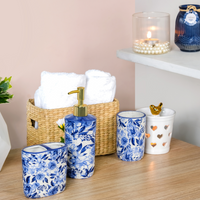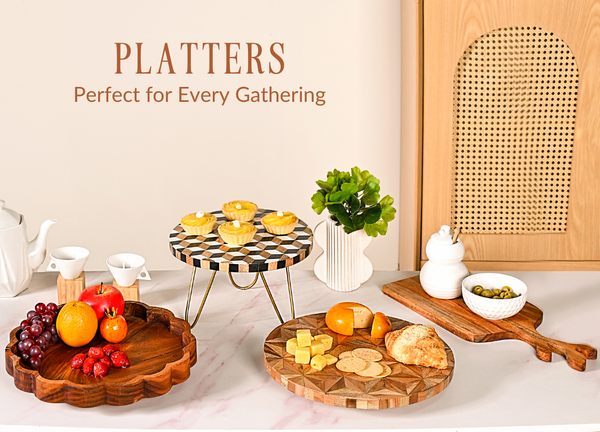Mindful Living
As the world has progressed, many of us have shifted towards a more sustainable approach to our everyday lives. Whether it's reducing waste, choosing eco-friendly products, or simply supporting brands that prioritise the planet, the shift is undeniable. This growing awareness is influencing everything from the food we eat to the products we decorate our homes with.

One area that's seeing a significant rise in sustainable practices is home decor. From the materials used to the manufacturing process, sustainability is becoming a cornerstone of modern design. Homeowners and interior designers alike are seeking pieces that aren’t just pretty to look at. Rather, such pieces that enter a space must also reflect certain values that consciously choose not to compromise on the environment.
A perfect example of this shift can be found in the candle industry. Once considered simple accessories for ambience, candles have now become emblems of conscious consumerism. We’re no longer content with just enjoying a pleasant scent or warm glow; there’s a growing demand for candles made from eco-friendly materials that respect the planet. And this movement towards sustainability isn't just the latest hot trend everyone is trying to hop onto to stay relevant. No, dear reader. This shift is part of a greater conversation about how we can live more mindfully and reduce our carbon footprint.
What Are Sustainable Candles?
Before we delve into how to choose sustainable candles, it's important to gain a thorough understanding of what a sustainable candle really is. So grab your notebooks and buckle in, because class is officially in session.
Long story short, sustainable candles are made from natural, renewable, and, most importantly, biodegradable materials that have a much lower environmental impact than their traditional counterparts. However, short story long, for candles to truly be considered sustainable, there are a few factors and parameters that must be considered.
1. Natural Materials:
When we think of sustainable candles, most of us immediately focus on the wax. Whether it's soy wax, beeswax, or coconut wax. And while wax is pretty much the entirety of a candle, every part of the candle, from the wick that files the flame to the container it rests in, contributes to its carbon footprint.

For example, eco-friendly candles replace the typical synthetic or lead core wicks with cotton and wooden wicks, ensuring a cleaner burn. The actual containers are often made from glass, metal, or ceramic, making them reusable or recyclable, thus, minimizing waste long after the candle has burned out.
2. Natural Fragrances:
Many conventional candles use artificial fragrances that are packed with phthalates and other chemicals, which can harm both our health and the environment. However, eco-friendly candles embrace natural, non-toxic alternatives, using essential oils extracted from flowers, herbs, and fruits. These oils and fragrances not only provide authentic aromas but also allow us to reap the benefits of aromatherapy.
3. Burn Time:
Sustainable candles are designed to burn longer and more evenly, significantly enhancing their value and effectiveness. Unlike conventional candles that burn down quickly, eco-friendly candles steady the pace at which they melt through the quality of the wax, wicks, and ingredients used. This added longevity makes these candles more economical and eco-friendly, as you get more use out of a single candle, reducing the frequency at which it needs to be replaced.
4. Manufacturing Process:
The method of production of sustainable candles can be seen as a bit of a zen koan. On one hand, hand-poured candles are considered a true luxury. They offer that rare artisanal quality, allowing us to experience craftsmanship and individuality in each piece while also supporting job sustainability and local economies.
On the other hand, mass-produced candles have the advantage of lower energy consumption in terms of wattage per candle, making them more efficient from an environmental standpoint. Mass production often leads to reduced energy usage across the board, which can have a more significant positive impact on reducing the overall carbon footprint.
Ultimately, both approaches have their merits. The key lies in balancing the two methods to create a production process that benefits both the planet and the people involved.
Why Make The Switch?
Health Implications:
Sustainable candles aren’t just kind to the environment. They’re kind to your environment. Traditional candles made from paraffin wax emit harmful chemicals such as benzene and toluene into the air when they burn, leading to serious health risks. And sustainable candles…well…don’t as they use natural products.
Long-Term Sustainability:
We’ve already established that sustainable candles burn longer, reducing the need for frequent replacements. But the impact goes far beyond just keeping fewer leftover candles out of landfills.
The production of paraffin candles relies heavily on petroleum, a non-renewable resource that contributes to environmental degradation and carbon emissions. Extracting and refining petroleum not only depletes finite resources but also generates pollution at every stage of the process. By switching to candles made from natural, renewable materials like soy, beeswax, and coconut wax, we can help reduce our reliance on fossil fuels.
The Bottom Line:
Choosing sustainable candles, much like sustainable home decor, is about weaving mindfulness into the fabric of our daily lives. Every candle lit becomes a reminder that even the smallest choices can contribute to a healthier planet.






















